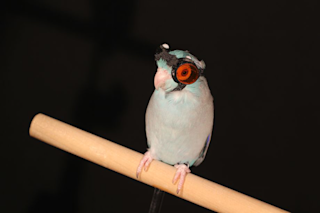The fearless research subject, ready for flight. (Credit: Lentink Lab/Stanford University) Sometimes, it takes a goggle-wearing parrot to show us where we went wrong. A study from researchers at Stanford University suggests that our previous models of lift, as they pertain to animals, are all incomplete, based on observations of an intrepid parrotlet in their laboratory. Flying through a sheet of illuminated aerosol particles, the avian aviator pushed through the boundaries of our current understanding of wake dynamics, hinting that there is new ground yet to be broken.
The Stanford researchers were studying the way that air currents behave in the wake of the birds' wings. When wings slice through the air, they leave behind swirls of current, similar to the whirlpools that form when you push a canoe paddle through the water. In jet airliners, these vortices hang in the air for some time, often extending for over half ...














